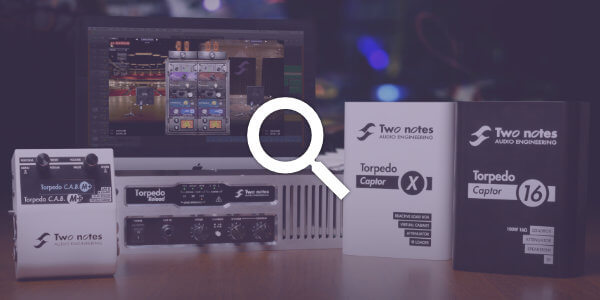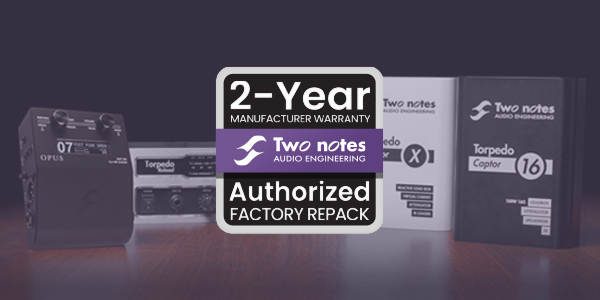Simply put, the Two notes DynIR are dynamic where as a regular impulse response is static. By static, we mean that they have only one mic, only on one speaker, that only in one position and have no other parameters for you to tweak. DynIR takes the concept of a static impulse response and expands it enormously. Each DynIR Virtual Cabinet you buy from Two notes comes with 8 microphones and a choice of multiple rooms and (most importantly) you can move the mics around either in front or behind the cabinet. This gives you the ability to hear the difference the tweaks make in actual real time. Products such as Captor X, C.A.B. M+ and others that can be controlled by Torpedo Remote (Cap X and CAB M+ are controllable via your mobile / tablet, wirelessly), you can choose 2 mics per cab – the difference a second mic makes will blow your mind, and it’s all there in the unit. When using the Wall of Sound plug in you can use up to 20 different cabinets, each with different mics, each within a different room… the possibilities are almost endless.
 When you look into the details of each impulse response file, which is usually a .wav file, they tend to be around 100kb, which, you know, is small. But, when you consider DynIR has around 20,000 variants just from mic position (front and back) alone, and then times that by 8 (for each mic) and you get 160,000. If there are 8 rooms, makes that 1,280,000 separate equivalents of 1 impulse response file, that’s 1.28 gig of files compared to the couple of Mb that each DynIR files takes up. What is easier to manage and utilize within your work flow? One file that is loaded into Torpedo Remote, or having to sift through 1.28 million separate files? And that is just 1 DynIR virtual cabinet… most of our hardware ships with between 16 and 32 DynIR cabinets, so…. compare that to the equivalent of separate files – it becomes unimaginable.
What tends to happen is that people rely on a handful of impulse responses, their go-to few that they can trust. This leaves the guitar tones sounding predictable, and maybe even a little stale after a while. A little shift performed on one of the mics in the DynIR system opens up a whole tonal spectrum that you would have to hunt for hours for within your regular impulse response library.
When you look into the details of each impulse response file, which is usually a .wav file, they tend to be around 100kb, which, you know, is small. But, when you consider DynIR has around 20,000 variants just from mic position (front and back) alone, and then times that by 8 (for each mic) and you get 160,000. If there are 8 rooms, makes that 1,280,000 separate equivalents of 1 impulse response file, that’s 1.28 gig of files compared to the couple of Mb that each DynIR files takes up. What is easier to manage and utilize within your work flow? One file that is loaded into Torpedo Remote, or having to sift through 1.28 million separate files? And that is just 1 DynIR virtual cabinet… most of our hardware ships with between 16 and 32 DynIR cabinets, so…. compare that to the equivalent of separate files – it becomes unimaginable.
What tends to happen is that people rely on a handful of impulse responses, their go-to few that they can trust. This leaves the guitar tones sounding predictable, and maybe even a little stale after a while. A little shift performed on one of the mics in the DynIR system opens up a whole tonal spectrum that you would have to hunt for hours for within your regular impulse response library.
When cabinets are captured for DynIR, there is no digital replication of the difference between each microphone, each cabinet is captured using the actual mic stated within a room, in multiple places, in order to make the DynIR file as authentic as possible so that you have complete control over them, as well as your guitar tone!





 Terms and Conditions apply
Terms and Conditions apply
Okay, are in the Torpedo Live also DynIR because I can mix two mics?
All of our cabinet’s are DynIR 🙂 You can use 2 mics in Live on one cabinet! (If you use Remote v5)
Bonjour, vous avez du pain sur la planche ont dirais bien que vous vous êtes fait dépasser par la suède ?
https://www.youtube.com/watch?v=_Im3T-h7SWQ&ab_channel=BogrenDigital
IRDX. Allez vous reprendre votre place des meilleurs au monde ? Et j’ai entendu dire que votre DynIR est semblable a ce que fait Amplitube de IK multimédia et que la DynIR c’est juste qu’on peu déplacer le micro en émulation comme Amplitube et les autres du même type. Rassurer moi que vous allez changer la donne et que tout le matérielle que j’ai acheté soit en mesure d’écraser la compétition comme prévue. Genome est très attendue comme interface car wall of sound commence a faire ancien ! Allez vous botter le cul de la compétion ? en tous les cas je l’espère, Merci.